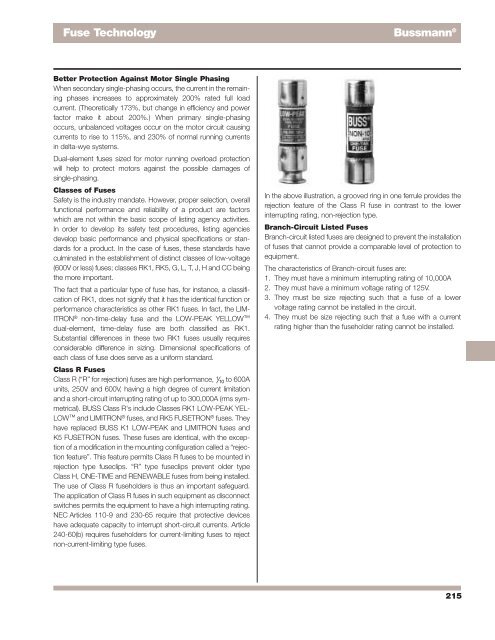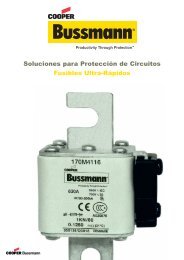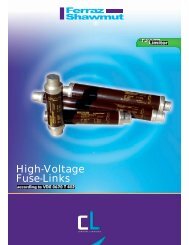Bussmann
Create successful ePaper yourself
Turn your PDF publications into a flip-book with our unique Google optimized e-Paper software.
Fuse Technology<br />
<strong>Bussmann</strong> ®<br />
Better Protection Against Motor Single Phasing<br />
When secondary single-phasing occurs, the current in the remaining<br />
phases increases to approximately 200% rated full load<br />
current. (Theoretically 173%, but change in efficiency and power<br />
factor make it about 200%.) When primary single-phasing<br />
occurs, unbalanced voltages occur on the motor circuit causing<br />
currents to rise to 115%, and 230% of normal running currents<br />
in delta-wye systems.<br />
Dual-element fuses sized for motor running overload protection<br />
will help to protect motors against the possible damages of<br />
single-phasing.<br />
Classes of Fuses<br />
Safety is the industry mandate. However, proper selection, overall<br />
functional performance and reliability of a product are factors<br />
which are not within the basic scope of listing agency activities.<br />
In order to develop its safety test procedures, listing agencies<br />
develop basic performance and physical specifications or standards<br />
for a product. In the case of fuses, these standards have<br />
culminated in the establishment of distinct classes of low-voltage<br />
(600V or less) fuses; classes RK1, RK5, G, L, T, J, H and CC being<br />
the more important.<br />
The fact that a particular type of fuse has, for instance, a classification<br />
of RK1, does not signify that it has the identical function or<br />
performance characteristics as other RK1 fuses. In fact, the LIM-<br />
ITRON ® non-time-delay fuse and the LOW-PEAK YELLOW<br />
dual-element, time-delay fuse are both classified as RK1.<br />
Substantial differences in these two RK1 fuses usually requires<br />
considerable difference in sizing. Dimensional specifications of<br />
each class of fuse does serve as a uniform standard.<br />
Class R Fuses<br />
Class R (“R” for rejection) fuses are high performance, ⁄Ω¡º to 600A<br />
units, 250V and 600V, having a high degree of current limitation<br />
and a short-circuit interrupting rating of up to 300,000A (rms symmetrical).<br />
BUSS Class R's include Classes RK1 LOW-PEAK YEL-<br />
LOW and LIMITRON ® fuses, and RK5 FUSETRON ® fuses. They<br />
have replaced BUSS K1 LOW-PEAK and LIMITRON fuses and<br />
K5 FUSETRON fuses. These fuses are identical, with the exception<br />
of a modification in the mounting configuration called a “rejection<br />
feature”. This feature permits Class R fuses to be mounted in<br />
rejection type fuseclips. “R” type fuseclips prevent older type<br />
Class H, ONE-TIME and RENEWABLE fuses from being installed.<br />
The use of Class R fuseholders is thus an important safeguard.<br />
The application of Class R fuses in such equipment as disconnect<br />
switches permits the equipment to have a high interrupting rating.<br />
NEC Articles 110-9 and 230-65 require that protective devices<br />
have adequate capacity to interrupt short-circuit currents. Article<br />
240-60(b) requires fuseholders for current-limiting fuses to reject<br />
non-current-limiting type fuses.<br />
In the above illustration, a grooved ring in one ferrule provides the<br />
rejection feature of the Class R fuse in contrast to the lower<br />
interrupting rating, non-rejection type.<br />
Branch-Circuit Listed Fuses<br />
Branch-circuit listed fuses are designed to prevent the installation<br />
of fuses that cannot provide a comparable level of protection to<br />
equipment.<br />
The characteristics of Branch-circuit fuses are:<br />
1. They must have a minimum interrupting rating of 10,000A<br />
2. They must have a minimum voltage rating of 125V.<br />
3. They must be size rejecting such that a fuse of a lower<br />
voltage rating cannot be installed in the circuit.<br />
4. They must be size rejecting such that a fuse with a current<br />
rating higher than the fuseholder rating cannot be installed.<br />
215






